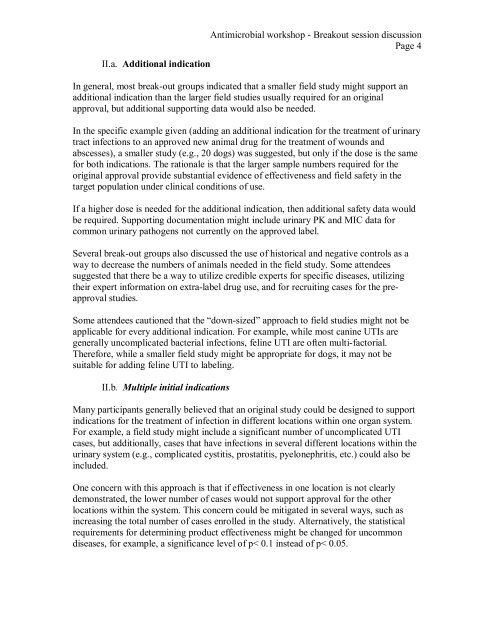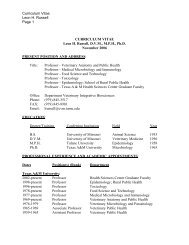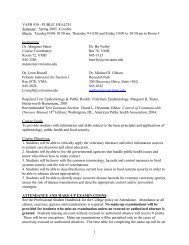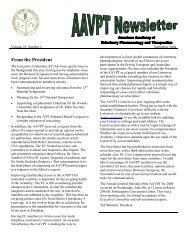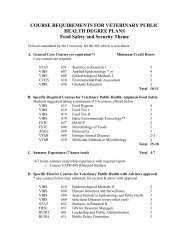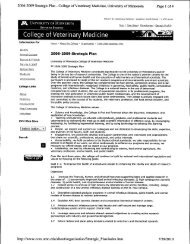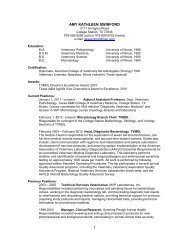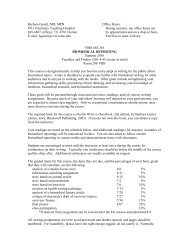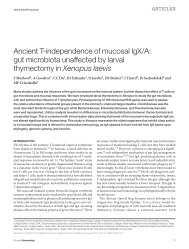BreakOut Session Addendum to the October 2008 Antimicrobial ...
BreakOut Session Addendum to the October 2008 Antimicrobial ...
BreakOut Session Addendum to the October 2008 Antimicrobial ...
Create successful ePaper yourself
Turn your PDF publications into a flip-book with our unique Google optimized e-Paper software.
II.a. Additional indication<br />
<strong>Antimicrobial</strong> workshop Breakout session discussion<br />
Page 4<br />
In general, most breakout groups indicated that a smaller field study might support an<br />
additional indication than <strong>the</strong> larger field studies usually required for an original<br />
approval, but additional supporting data would also be needed.<br />
In <strong>the</strong> specific example given (adding an additional indication for <strong>the</strong> treatment of urinary<br />
tract infections <strong>to</strong> an approved new animal drug for <strong>the</strong> treatment of wounds and<br />
abscesses), a smaller study (e.g., 20 dogs) was suggested, but only if <strong>the</strong> dose is <strong>the</strong> same<br />
for both indications. The rationale is that <strong>the</strong> larger sample numbers required for <strong>the</strong><br />
original approval provide substantial evidence of effectiveness and field safety in <strong>the</strong><br />
target population under clinical conditions of use.<br />
If a higher dose is needed for <strong>the</strong> additional indication, <strong>the</strong>n additional safety data would<br />
be required. Supporting documentation might include urinary PK and MIC data for<br />
common urinary pathogens not currently on <strong>the</strong> approved label.<br />
Several breakout groups also discussed <strong>the</strong> use of his<strong>to</strong>rical and negative controls as a<br />
way <strong>to</strong> decrease <strong>the</strong> numbers of animals needed in <strong>the</strong> field study. Some attendees<br />
suggested that <strong>the</strong>re be a way <strong>to</strong> utilize credible experts for specific diseases, utilizing<br />
<strong>the</strong>ir expert information on extralabel drug use, and for recruiting cases for <strong>the</strong> pre<br />
approval studies.<br />
Some attendees cautioned that <strong>the</strong> “downsized” approach <strong>to</strong> field studies might not be<br />
applicable for every additional indication. For example, while most canine UTIs are<br />
generally uncomplicated bacterial infections, feline UTI are often multifac<strong>to</strong>rial.<br />
Therefore, while a smaller field study might be appropriate for dogs, it may not be<br />
suitable for adding feline UTI <strong>to</strong> labeling.<br />
II.b. Multiple initial indications<br />
Many participants generally believed that an original study could be designed <strong>to</strong> support<br />
indications for <strong>the</strong> treatment of infection in different locations within one organ system.<br />
For example, a field study might include a significant number of uncomplicated UTI<br />
cases, but additionally, cases that have infections in several different locations within <strong>the</strong><br />
urinary system (e.g., complicated cystitis, prostatitis, pyelonephritis, etc.) could also be<br />
included.<br />
One concern with this approach is that if effectiveness in one location is not clearly<br />
demonstrated, <strong>the</strong> lower number of cases would not support approval for <strong>the</strong> o<strong>the</strong>r<br />
locations within <strong>the</strong> system. This concern could be mitigated in several ways, such as<br />
increasing <strong>the</strong> <strong>to</strong>tal number of cases enrolled in <strong>the</strong> study. Alternatively, <strong>the</strong> statistical<br />
requirements for determining product effectiveness might be changed for uncommon<br />
diseases, for example, a significance level of p< 0.1 instead of p< 0.05.


